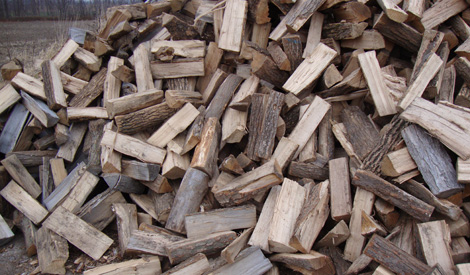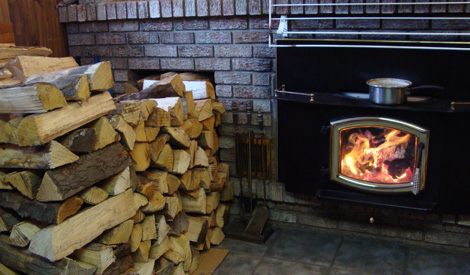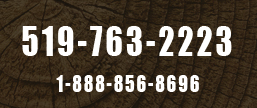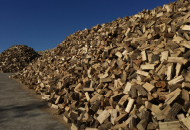Wood-Informed
Find out all the answers to many commonly asked questions and concerns relating to firewood here. Why should you burn firewood? What should you look for when you buy your wood? What do we mean when we refer to a "cord" of wood? Take a few minutes to inform yourself about firewood, so you can make a well-informed decision about it.
Around Christmas time each year we deliver well seasoned wood from indoor storage.
Serious Wood Burner's Tips | Why Heat with Firewood?
All About Firewood | Firewood Measures | Storing Your Wood
Building your Fire | Precautions
The Serious Wood Burner's Tips (so you don't get burned!)
So, you ask: "what’s the best time of year to buy my wood supply to ensure that I can burn it when the weather starts getting colder?" – "Where should I stack my wood?" "I have a large wood stove/fireplace, and I need it split in larger pieces." "I have a small stove and I need my wood cut and split into finer pieces." This is a good place to start, as you take responsibility for making sure that you have well - seasoned wood to burn. (This is not the responsibility of the local wood business.)
I’ll give you a clue: The time to ask is not when you’re burning your last stick of wood, or if the weather is already cold/rainy! But if you find yourself in that spot, all is not lost...read on.
Our top recommendation that many customers have been following for the past 20 plus years, is to purchase unseasoned wood in the spring, and there are many advantages to this:
- We offer a Spring Special discount on one full cord or more. So you’ll save money.
- You now have your firewood supply and you can stack it in the most optimum sunny and windy spot to ensure it is woodstove/fireplace ready in the fall.
- You won’t need to worry about the amount of precipitation received between the spring and fall with your smaller pile of wood. (Compared to the hundreds of orders we need to store to keep up with the growing demand of the wood burners in the southern Ontario region)
- You also won’t have to worry about receiving a delivery of frozen wood in the dead of winter. We store it indoors before the weather turns nasty, but it still freezes in there! Moisture can still get trapped into the wood, requiring you to thaw it well before burning it. (If not, you will be steaming it!)
Our second best recommendation would be to purchase your wood supply as close to the beginning of September as possible. It is still warm then, and you will have the opportunity to stack it and let it air out while the weather is still nice. (Don’t worry -winter will come!) Once the temperature drops to the freezing mark, and especially if we are getting a fair amount of precipitation, we recommend you cover your wood, so no precipitation can freeze into the wood. Even if you have an ideal stacking spot, we recommend you bring it indoors for a week to two weeks before you actually need to burn it.
Here’s the scenario:
In the spring we stack a full cord of unseasoned wood at the back of the house where the sun/wind and rain can do its job. In the fall, we bring that cord into the basement, and stack another full cord where the previous one was. On Thanksgiving weekend we stack 2.5 full cords along the outside of our garage on the sidewalk. It is covered only by the soffit and fascia for the 3 or 4 months until we start moving it into our storage area, which is usually about January- February. Late October or early November, we stack another full cord along our driveway against the fence. We plan to burn it the following March - April, so it will eventually get moved to our indoor storage area about a month before we need to use it. If we don’t burn it all at that time, it will be there in the fall of the following year when the burning season starts again.
The words of Steve’s Dad resonate today: "If you’re burning wood, you should always be planning a year ahead."
And it’s great, because I never have to give it a second thought – I always have nice dry wood to burn!
Why Heat with Firewood
- Renewable energy resource - If forests are managed properly, they reproduce themselves naturally, meaning there will be wood for as long as we need it!
- Clean emissions - Seasoned firewood releases much less carbon dioxide into the atmosphere than fossil fuels (oil, coal, gasoline, etc.) and therefore keeps our air cleaner.
- Reliable and independent - Burning wood is an excellent primary or supplementary heating source; in case of power outages or crises, you do not have to depend on outside sources such as hydro or gas.
- Mmmm, warm! - Radiant heat from burning wood provides an excellent way to warm yourself, the room, or the whole house. Talk about cozy!
- Ahhhh, mood! - The smell... the heat... the crackling, popping, and flickering of a real wood fire... it's second to none in providing an intimate atmosphere for conversation.
- Economical - Well planned space heating is an excellent way of saving money.
- Friendly locals - The firewood providers in your community are always a local source of energy and better places for investment than the giant energy corporations.
- Cheap, eh! - Heating with wood is definitely a viable way of saving money and enjoying something truly Canadian!
All About Firewood
With the energy focus and rising gas prices around the world today, fireplaces and wood stoves are quickly becoming popular sources for heat around the country. As a heating fuel, firewood is a natural and renewable source that is very clean, efficient, and safe. It is easily accessible in most areas, too, adding to the convenience of this fuel.
As a supplementary source of heat, wood fires are ideal. They are easy to start, they provide a lot of heat, and they add a cheerful atmosphere to the room. Sufficient supply of air is required to be safe and efficient, though. To be used as a primary source of heat, you should make careful research and consideration to the benefits and negative aspects of wood heating.
Different types of wood have different heat content, depending on things like wood density, resin, ash, and moisture. Hardwoods typically contain the greatest total heating value per unit of volume, so they provide longer-burning fires. Softwoods are less dense and contain less total heating value per unit of volume; they give a fastburning, cracking blaze. The heat value of firewood is usually estimated by this generalization: "One full cord of well-seasoned hardwood (weighing approximately two tons) burned in an airtight, draft-controlled wood stove with a 55-65% efficiency is equivalent to approximately 175 gallons of #2 fuel oil or 225 therms of natural gas consumed in normal furnaces having 65-75% efficiencies."
Fully dried wood generally contains from 8,000 to 9,500 BTU of heat value per pound; air-seasoned wood contains from 5,500 to 8,500 BTU. When choosing your firewood, consider the heat value, along with these other characteristics: ease of splitting, weight per volume unit, ease of starting, amount of smoking, and coaling qualities.
If you have any further questions, feel free to contact us any time!
Firewood Measures
Firewood is measured in cubic feet. A full cord of firewood is 128 cubic feet, which would equate to a stacked pile of wood measuring 4 feet high by 4 feet deep by 8 feet long. This measurement is endorsed by Weights and Measures Canada. (see Measurement Canada) However we do provide smaller quantities. A quarter of a full cord (typically called a "face" cord) measures 32 cubic feet isa stack that measures 4 feet high by 8 feet long by 12 inches in length, or 3 feet hight by 8 feet long by 16 inches in length. A half-full cord is twice this amount, in other words, 2 rows of either lengths.

Storing Your Wood
When you store your firewood, you must keep in mind that you are affecting the quality of the wood by how you store it. Seasoned wood is best stored in the garage or beside the house, preferably not in dirt. Firewood will dry more quickly if there is more surface area exposed to the air; therefore, stack the wood in a dry spot, allowing for good air circulation.
Outdoor storage is best for firewood, in an area free from debris or vegetation. That way, animals and insects will be least likely to inhabit the stacks of wood. Protection from the elements also improves the life of your wood, keeping it at a maximum burnable state for as long as possible.
Building Your Fire
When starting your fire, you ideally want a combination of softwoods and hardwoods. The softwoods ignite more easily, while the hardwoods burn longer. Keep a thick bed of glowing coals; they help ignite new wood, and they produce a steady heat. At regular intervals, add an appropriate amount of wood. Fireplace and chimney maintenance is an important aspect to having good, safe fires. Visit this site for more information.

Precautions
Take care to only burn proper materials in your stove or fireplace. Coal and artifical logs should not be burned in an enclosed stove or fireplace. Artificial logs are made with wax that burns too hot for metal stoves and chimneys. These should only be burned in open brick fireplaces. Wood that has been treated with wood preservatives should also be avoided, since these chemical compounds are unsafe and unhealthy for burning. Wet, green, or resinous wood give off large amounts of tars, creosote and wood extractives which can be a safety risk; these should also be avoided.
| Request an Order Today | |
 |
|
|
|
|
|
| A creative web solution from Insight Studios |
|

